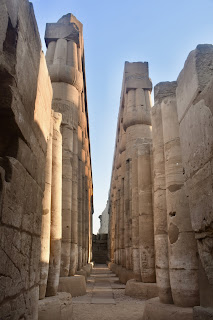Day 4 Aug 31 Part 2 Temple at Luxor
So after we settled in for a while, it was time to leave the ship and have an evening tour of the Temple of Luxor.
The views out the bus window were considerably different from those in Cairo.
Distances were also shorter. In no time we were entering the temple grounds.
Of course we picked up the Avenue of the Sphinxes again, this time seeing the version with the head of the king.
The Temple is known as the Southern Temple in Arabic (معبد الأقص), because it is south of the Temple of Karnak (connected by the Avenue of the Sphinxes).
Here is an overhead shot of the Temple from Google Earth
You can see the Avenue of the Sphinxes leading down to the temple.
This is a smaller complex than Karnak, but the structures are extremely well-defined in the shot.
Above are two statues of Ramses II at the first Pylon.
The Temple at Luxor was commissioned by Amenhotep III (1390-1353) late in the 18th Dynasty.
It was probably originally dedicated to Amon, Mut and Khonsu, but its purpose seems to have altered over the years and it became dedicated not to particular gods, but rather to the renewal of the king.
Tutankhamun (1333-1323 BCE) completed the temple begun by Amenhotep III.
Horemheb (1319 -1292 BCE) continued the work on the Temple.
Ramses II added a pylon and obelisks (and of course lots of references to his own greatness.)
Ptolemaic kings also made additions
This Nefertari (favorite wife and Queen of Ramses II) is properly placed at her husband's side showing her support of her husband according to our guide Yasser Farouk.
The papyrus tops of the columns are much more stylized than those we saw at Karnak.
The hypostyle hall has a colonnade of 14 pillars that are 52 feet high.
There were of course temple cats.
And they bear the thin sleek form that we see in cats depicted on the temple walls.
There were also a lot of hieroglyphic inscriptions and reliefs.
There is a granite shrine or chapel to Alexander the Great in one hall, and he claims to have been crowned in Thebes, but evidence suggests he never got that far south.
You can see Corinthian capitals on the columns and remnants of figures that seem to be dressed in togas in the niche.
They also believe that there is a statue or two of of Tutankhamun here.
We explored the complex and then before we knew it, it was time to head back for dinner.
In the Avenue of Sphinxes we noticed a replica of a boat so we could see a three-dimensional version of what we had seen on the temple walls.
As we boarded the ship we watched the sunset over the Valley of the. Kings (something we would be seeing soon).
That evening we passed the Viking sister ship the Aton.




































No comments:
Post a Comment